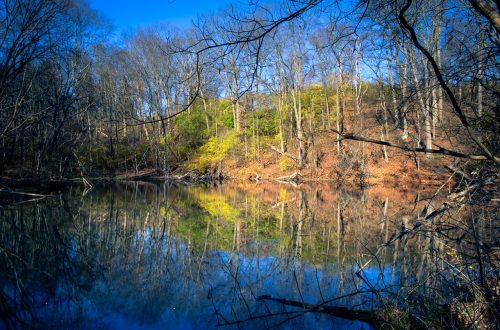Waiting for a Train
Well, hello, everyone. I know I haven’t written here in a little while. Jenny posted several stories earlier, but I haven’t said anything in a long time. I’m sitting right now at King’s Cross/St. Pancras International Rail Station, waiting to board a Eurostar train that will take me to Brussels. At the same time as I was getting on a Circle Line Underground train to King’s Cross, Jenny was boarding a Circle Line train in the opposite direction to Heathrow.
We had the opportunity to come to London again this year. I was coming for a conference, and Jenny was coming to enjoy some sightseeing. My conference was during the week, so we had the weekend free. We decided this year to rent a car and drive out of London to explore some of the surrounding area. This was probably one of our best ideas yet, inspired in no small part by Jenny’s cousin Rebbecca, who recently returned to the ‘States after spending almost a year in the UK.
The hotel in London was paid for, so we decided to base our operations there. If we didn’t have to find a place to stay Sunday night in order to get on our way to transportation today, then we were considering dumping the hotel and staying somewhere outside of the city. It was a lot easier to just keep our stuff in London, though, so that’s what we did. That meant we spent a good portion of both Saturday and Sunday driving, but it was great fun. We got to see a lot of the countryside, which was exactly what we wanted to do.
Saturday, we set out as soon as we could hire the car for the south of Wales. We were heading to Raglan Castle and Tintern Abbey. The car hire didn’t have any GPS units available when we were getting our car, so we got basic directions to Ring Road and out to the M40. We stopped for petrol (aka gasoline) along the M40 and bought a road atlas. This was possibly the best £12.50 that we spent. Jenny and I studied the area we were headed to, and she identified a couple of interesting-looking roads in order to get there. We fully intended to use the main motorways only to save time, and to get onto the more local roads near our destinations so that we could spend some time looking at the villages and towns along the way.
Driving in the UK was not nearly as difficult as I initially thought it would be. It turns out that driving on the wrong side of the car was actually pretty conducive to driving on the wrong side of the road. Having read-up on the road markings, signs, and general rules of the road for the UK, things were actually not too bad. I butchered the navigation of a few roundabouts, I know. They all had excellent markings and actually made a lot of sense, but there were a few times where I got a little nervous and took off following someone in front of me, which turned out to be the wrong road to take. Also, a few times the rumble strips on the “hard shoulder” on the left reminded me that I was favoring that side of the road a little more than I should have been. Once, the left side-view mirror reminded me that I was a little too close to a lorry parked on the side of a narrow village road. And once, on our last trip back into the city on Sunday night, while off of our intended path and somewhere near St. Paul’s Cathedral, a construction cone got the better of the left side. It left a tiny mark on the door, for which I’m sure to pay dearly, but it was totally worth it.
Speaking of driving rules in the UK, the national speed limit is 70MPH on main motorways and larger roads with dual carriageways. They mark this somewhat sensibly here. Speeds lower than 70 on main motorways are marked-off in 10MPH increments. Roads where the maximum national speed limit apply are marked with a black slash through a circle. Easy. Of course, it seems that, like in the US, many UK drivers interpret 70 as being equal to far higher a number. The national speed limit on single carriageways is 60MPH. It’s not often in the ‘States that we are allowed to drive 60MPH on twisty-turny roads with what seems like a short distance to the oncoming traffic next to you. Here, though, if you’re going even 55MPH on such a road, you’re likely to be overtaken. It’s fun, though, and definitely worth the effort to drive here at least once. For sure, if we ever come back, we’ll be doing it again.
Anyway, back to Saturday. We decided to head first for Tintern Abbey. We got a little lost when trying to find one of the more local roads off of the A40. We were looking for the A466 (still main enough to have a route number), which was supposed to turn directly off of the A40 near one of the villages along the road. We were already into Wales, and had started to notice signage in both Welsh and English. We missed the A466 somewhere, and ended up heading south a little more west than we had intended, towards Chepstow (Cas-Gwent). Following the trusty map, Jenny identified a different road that would take us to the abbey. We got there somewhere around 15:30. It was an astounding trip down this tiny road into Tintern, which is in the Wye River valley. Coming down the road, one could see the abbey ruins in the distance. It was a spectacular view. We paid the admission fees to walk around the grounds (I think it was £2.50/person or so–definitely reasonable). We were there until closing time at 17:00.
At this point, we realized that we had not eaten anything all day. We were having too much of a good time, and had completely forgotten about food. Earlier in the day, when we were buying the map, we bought a diet coke to drink the car. That’s all we had consumed all day. Realizing this, and that we were getting a bit tired, we stopped at an inn along the Wye River not too far from Tintern Abbey for food. They didn’t start serving until 18:00, so we had a couple of pints of Guinness (poured by a fine Welsh waitress who was interested to hear about our travels and recommended several other local sites). Once food was available, we had some good food there, and then started our journey back to London. It was rainy and chilly, and perfect ambiance for driving in the English countryside. I was somewhat apprehensive about our approach back into London, but Jenny and the map did well, and we arrived safely back at our hotel.
At the hotel, I asked about where to park the car. I thought they might have a valet service, as they were a pretty fancy hotel. Sadly, they did not. However, the night concierge (it was after 23:00 by the time we got there) said just to park it in the small lot in front of a couple of other cars, and to leave the keys with him. We tipped him, said thank you, went upstairs, and collapsed into bed after a fun adventure.
Sunday morning, we intended to go to a nearby Catholic church for Mass. Unfortunately, the lousy alarm clock and our tiredness from the previous day didn’t cooperate well, and we didn’t get up until 10:30 or so. We got our stuff together and ran out to get the car and get on our way to the day’s adventure, which was a trip to Avebury.
Avebury is a village west of London, but not quite into Wales yet. There are several Neolithic and pre-Neolithic sites around the area. The village itself is built in and around a stone henge, made up of large stones sitting on-end, with a large ditch and earthen mound around them. On our way into the village, we stopped first at Silbury Hill, which is a Neolithic mound, almost perfectly circular, that rises about 130 feet above the rolling farmland. Archaeological investigation shows that it was built in several phases, the last being mostly local chalk. Though covered with turf today, a giant white mound rising that far above the local terrain would have been quite a sight, and probably visible for a long distance.
After visiting the hill, we walked back to the car, which we had parked along the side of the road. We saw a lot of people walking through what looked like a farmer’s field. We looked around and discovered that they were headed up a path to West Kennet Long Barrow, which is a Neolithic-era stone tomb that is quite long. Probably built in two phases, the barrow is still there, as are the huge stones that make up its walls. The local signage says that it was built around 3600 BC. About 1000 years later, at around 2500 BC, it was purposely filled-in. There were at least 46 people buried there, and it is unknown why it was purposely closed. It, too, was pretty amazing. At almost 100 meters long, it is one of the longest barrows in the UK.
We walked back down to the car, and then drove into Avebury. We walked around the village and henge there a good bit. I even got Jenny to climb the earth mound surrounding the henge with me. Most of the area is currently sheep pasture, so we were walking around with sheep everywhere. It was fun.
Inside the village, we walked around just a little bit. We visited a church in the middle of the village. Inside were some historical details of the local community. It said there that there was evidence of a Christian community from about 300 AD. A Roman road went through the area, and there were apparently a group of Christians who settled in the area. The existing church dates primarily from the 1800’s, but its earliest parts are much older than that, dating back centuries before the last major restoration work took place in the late 1800’s. In fact, when King Henry VIII suppressed Roman Catholic worship in the kingdom, the parishioners took important parts of the screen and symbols of Catholicism and hid them behind a new plaster wall. 250 years later, they were discovered while work was being done in the church. Some parts of those details were used to replace missing items in the church. Today, it exists as a parish of the Church of England.
I have more to write, but it is getting close to time for me to find my train. I’m going to finish this salmon sandwich and get on my way. Jenny couldn’t stay for the remainder of my trip to Rotterdam, so she’s on her way home. She’ll be home tonight. I’ll be in Rotterdam tonight.
jonathan



One Comment
Aphra99
The tomb was probably sealed up because the the neighborhood kids of the time were most likely doing bad things there. Whatever those bad things were in 2500 BC…
The Shiebster would be happy to know that you walked where Romans walked. It sounds like you got to see some neat places! Hope the rest of your trip goes well. Stay safe!